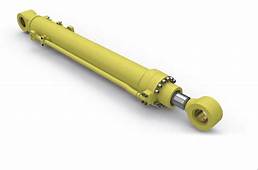Hydraulic cylinder or linear hydraulic motor is a mechanical actuator that can be used as undirectional energy by using undirectional stroke. It is mainly used in construction, engineering vehicles, civil engineering and manufacturing applications.
They get their power from hydraulic oil. The barrel is linked to the pistons that go back and forth. The barrel is closed on one end by the cylinder bottom or cap and the other end by the cylinder head or gland where the piston rod comes out of the cylinder. The piston has sliding rings and seals. The piston splits within the inside of the cylinder into two chambers, the bottom chamber or cap end and the piston rod side chamber, rod end/head-end. The piston rod also has mounting attachments to connect the cylinder to the object or machine component that it is pushing or pulling. Mounting styles are flanges, clevises and trunnions.
The “generator” side of the hydraulic system is the pump that is a fixed or regulated flow of oil to the hydraulic cylinder, to move the piston. There are three types of pump widely used: hydraulic hand pump, hydraulic air pump, and hydraulic electric pump.The piston pushes the oil in the other chamber back to the reservoir. If we assume that the oil enters from the cap end, during extension stroke, and the oil pressure in the rod end/head end is approximately zero, the force F on the piston rod equals the pressure P in the cylinder times the piston area A:
The main function of the cap is to enclose the pressure chamber at one end. The cap is connected to the body by means of welding, threading, bolts, or tie rods. Caps also perform as cylinder mounting components [cap flange, cap trunnion, cap clevis]. Capsize is determined based on the bending stress and seals go in between the caps and barrels.
The seals are considered/designed as per the cylinder working pressure, cylinder speed, temperature, working medium, and application. Piston seals are dynamic seals, and they can be single-acting or double-acting. Generally speaking, Elastomer seals made from the rubber. The wear bands are designed as per the side load requirements. The primary compounds used for wear bands are filled PTFE, woven fabric reinforced polyester resin, and bronze
Tie rod style hydraulic cylinders use high strength threaded steel rods to hold the two end caps to the cylinder barrel. They are most often seen in industrial factory applications. Small-bore cylinders usually have 4 tie rods, and large bore cylinders may require as many as 16 or 20 tie rods in order to retain the end caps under the tremendous forces produced. Tie rod style cylinders can be completely torn down for service and repair, and they are not always customizable.
If we can assist you with your next cylinder repair call us at 662-871-8403
